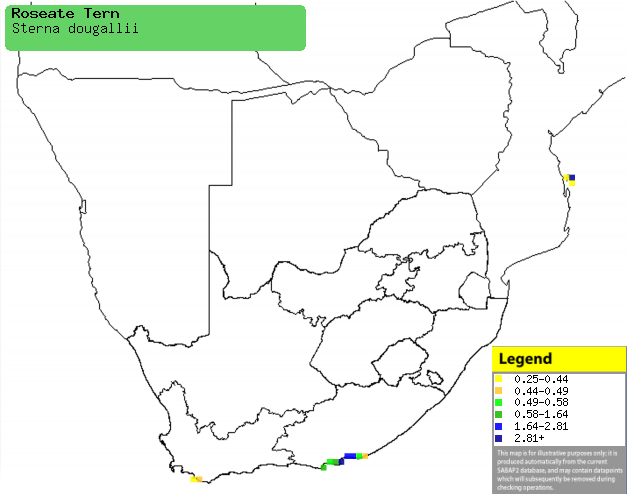|
Sterna dougallii (Roseate
tern)
Rooiborssterretjie [Afrikaans]; Dougall-stern [Dutch];
Sterne de Dougall [French]; Rosenseeschwalbe [German]; Gaivina-rósea
[Portuguese]
Life
> Eukaryotes >
Opisthokonta
> Metazoa (animals) >
Bilateria >
Deuterostomia > Chordata >
Craniata > Vertebrata (vertebrates) > Gnathostomata (jawed
vertebrates) > Teleostomi (teleost fish) > Osteichthyes (bony fish) > Class:
Sarcopterygii (lobe-finned
fish) > Stegocephalia (terrestrial
vertebrates) > Tetrapoda
(four-legged vertebrates) > Reptiliomorpha > Amniota >
Reptilia (reptiles) >
Romeriida > Diapsida > Archosauromorpha > Archosauria >
Dinosauria
(dinosaurs) > Saurischia > Theropoda (bipedal predatory dinosaurs) >
Coelurosauria > Maniraptora > Aves
(birds) > Order: Charadriiformes
> Family: Laridae > Genus: Sterna
Distribution and habitat
Occurs along the Atlantic coasts of North America and
western Europe, as well as in Arabia, Australia, Asia, southern Madagascar and
the coastline of mainland Africa, largely excluding the west coast. It is
uncommon and localised in southern Africa, with the largest breeding population
on Bird Island in Algoa Bay, Eastern Cape, with an even smaller colony on Dyer
Island off the western Cape. It generally prefers coastal and marine areas,
typically breeding on offshore islands and roosting there as well, or on
sandbanks and rocky outcrops at a river mouth.
|
 |
|
Distribution of Roseate tern in southern Africa,
based on statistical smoothing of the records from first SA Bird Atlas
Project (©
Animal Demography unit, University of
Cape Town; smoothing by Birgit Erni and Francesca Little). Colours range
from dark blue (most common) through to yellow (least common).
See here for the latest distribution
from the SABAP2. |
Predators and parasites
Its eggs are eaten by Larus dominicanus (Kelp gull).
Movements and migrations
Largely resident in southern Africa, although
when the breeding season finishes in October, it tends to disperse
across the coast adjacent to the island, heading back to breed again
in May.
Food
Mainly eats fish, doing most of its foraging in flocks of
20-100, often in association with other birds, such as
African penguins,
gulls and other terns, catching
most of its prey by plunge-diving. The following food items have been recorded
in its diet:
- Fish
- sandfish (Gonorhynchidae)
- fingerfins (Cheilodactylidae)
- bathyclupeids (Clupeidae)
- elf (Pomatomidae)
- kingfishes (Carangidae)
- barracudas (Sphyraenidae)
Breeding
- Monogamous, with a colony of less than 20 pairs at Dyer Island, Western
Cape and one with over 240 pairs at Bird Island, Eastern Cape. It performs a
spectacular courtship display in which both sexes ascend high in the sky
before gliding down back to the ground.
- The nest is a shallow scrape in the ground, usually surrounded by
vegetation and sometimes lined with plant and animal debris.
- Egg-laying season is from June to early July.
- It lays 1-2 eggs, which are incubated by both sexes for about 25 days.
- The chicks leave the nest at about 7-12 days old, taking their first
flight at 23-28 days old and becoming fully independent 20 days later.
Threats
Not globally threatened, but Endangered in South
Africa, as its population dramatically decreased in the country from the 1930's
to 1970's, although since then it has been on the increase. The predation of
eggs by Kelp gulls is though to be having a significant affect on breeding
success.
References
-
Hockey PAR, Dean WRJ and Ryan PG 2005. Roberts
- Birds of southern Africa, VIIth ed. The Trustees of the John Voelcker
Bird Book Fund, Cape Town.
|
